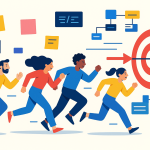Agile is not just a set of practices, tools, or frameworks. Agile is a mindset, a way of thinking and working that focuses on delivering value to the customer and responding to change. However, many organizations struggle to adopt the agile mindset because they are too attached to the agile labels, such as Scrum, Kanban, or OKRs. These labels can be useful, but they can also become a hindrance if they are followed rigidly or dogmatically, without understanding the underlying principles and values.
In his article, How to Become Agile Without the Agile Labels, Steve Denning argues that the agile labels are not essential for achieving agility. He suggests that organizations can become agile by following three simple steps:
- Start with the customer: The customer is the ultimate judge of value, and the primary goal of any agile organization is to satisfy the customer’s needs and wants. Therefore, organizations should start by identifying who their customers are, what problems they have, and how they can solve them. They should also seek feedback from the customer frequently and use it to improve their products and services.
- Create small, self-organizing teams: Small teams are more agile than large teams, because they can communicate and collaborate more effectively, make decisions faster, and adapt to change more easily. Self-organizing teams are more agile than hierarchical teams, because they can leverage the collective intelligence, creativity, and autonomy of their members, without being constrained by bureaucracy, micromanagement, or command-and-control. Therefore, organizations should create small, cross-functional teams that can work independently and deliver value to the customer in short iterations.
- Embrace experimentation and learning: Experimentation and learning are the keys to innovation and improvement in an agile organization. Instead of following a fixed plan or a predefined process, agile teams should embrace uncertainty and ambiguity, and use empirical methods to test their assumptions, validate their hypotheses, and learn from their failures. Therefore, organizations should foster a culture of curiosity, exploration, and feedback, where teams can try new ideas, measure their outcomes, and learn from their results.
By following these three steps, organizations can achieve agility without relying on the agile labels. However, this does not mean that the agile labels are useless or irrelevant. On the contrary, the agile labels can be very helpful, as long as they are used as a means to an end, not as an end in themselves. The agile labels can provide guidance, inspiration, and support for organizations that want to embrace the agile mindset, but they should not be seen as prescriptions, rules, or dogmas that must be followed blindly or rigidly.
The agile labels are not the essence of agility. The essence of agility is the agile mindset, which can be expressed in different ways, depending on the context, the situation, and the people involved. Therefore, organizations should not be obsessed with the agile labels, but rather focus on the agile mindset, and use the agile labels as tools, not as goals. By doing so, they can become more agile, without the agile labels.





